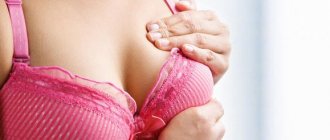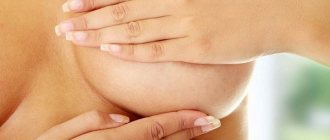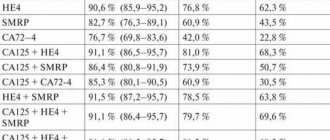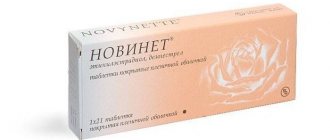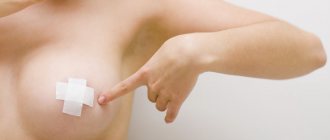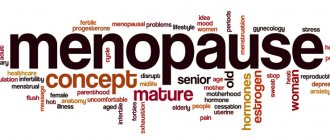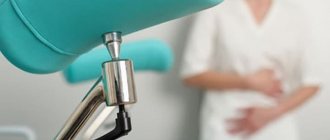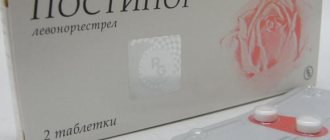Causes and associated symptoms
Redness of the breast can be caused by various factors. One of the most common ones is the first weeks of feeding. As a rule, problems begin with the appearance of cracks in the nipples. The breasts become red during breastfeeding if a woman suffers from various diseases.
Cracked nipples
As soon as the baby begins to feed on mother's milk, women complain of cracked nipples. They do not appear immediately. At first, my breasts hurt during feeding. After some time, red spots appear. After 3-4 days, the red areas bleed.
Lactostasis
Women call this problem the most pressing, since almost all mothers face it. The main symptom of the disease is breast hardness. If the mammary glands do not empty enough, this leads to blockage of the ducts.
In addition to pain, the woman develops a fever, her breasts become hard, and a certain area feels tight.
Lactostasis occurs due to the use of incorrect feeding techniques and premature weaning of the baby. Women experience lactostasis if they feed their children against their wishes.
Mastitis
The presence of lactostasis in a woman leads to the development of mastitis. Milk that is not promptly removed from the mammary glands leads to tissue swelling. In turn, they begin to become inflamed. The woman’s condition worsens, her breasts cannot be touched, and her body temperature rises.
Breast abscess
If a woman is diagnosed with mastitis and appropriate treatment is not prescribed, an abscess develops as a result of the disease. At the site of engorgement, the resulting cavity is filled with pus. It penetrates into milk, so feeding the child at the time of illness is suspended. An abscess often develops in only one breast.
After the examination, the doctor may allow the baby to be fed from a healthy mammary gland. In case of an abscess, self-medication is prohibited.
Hypogalactia
The appearance of lumps in the mammary glands is not the only problem women face. During breastfeeding, organs stop functioning. When the baby is born, the mother's breast does not produce milk. As a result, lactation is impossible.
There are no characteristic symptoms of hypogalactia. The breasts look normal, there is no redness. The mammary glands do not enlarge, but the child’s behavior changes. With hypogalactia, milk can be produced. But after 3-4 weeks the amount gradually decreases. There are no disturbances in the functioning of other organs.
Possible causes of red spots on the body on the chest
In most cases, red spots appear due to:
- allergic reactions;
- oncology;
- fungal infection;
- injury to a mole;
- scabies mite;
- psycho-emotional overload;
- acne;
- eczema.
Attention! The cause of the red spot can often be determined after visiting a doctor and performing an examination.
Allergy
Allergic reactions often manifest as changes in skin color. If a red spot appears under the breast due to an allergy, itching is usually also observed. To eliminate a defect on the skin, the allergen should be detected and eliminated:
- Food products. Some people experience red spots on the chest area after eating chocolate, peanuts, fish, milk or other foods.
- Medications. Allergies occur due to intolerance to certain components of the drug.
- Cosmetical tools. When applying products to the skin, allergic reactions and hypersensitivity may occur.
- Solar radiation. Red spots on the skin are characteristic of solar allergies.
Important! Quite often the allergen is dust, as well as animal hair and fluff.
Mastitis
Experts call mastitis a pathological inflammatory process that occurs in the tissues of the mammary glands. The disease is accompanied by the appearance of red spots on the skin of the chest and an increase in temperature. Patients are concerned about bursting pain and tightness in the breast area, chills and weakness.
The inflammatory process occurs due to the penetration of pathogenic microorganisms into the mammary gland, which significantly increases in size. The pathology is typical for lactating women, which is associated with stagnation of milk and violation of the rules of pumping.
Important! About 85% of lactating women with mastitis are primigravidas. Sometimes mastitis occurs in women who are not breastfeeding after 30 years of age, which is associated with impaired functioning of the immune system and chronic diseases.
Mastitis is often caused by staphylococcus. Damage to breast tissue by bacterial flora and E. coli is also possible. In the vast majority of cases, prolonged lactostasis leads to mastitis. Stagnation of milk and its long-term absence in certain areas of the gland form a favorable environment necessary for the life of pathogenic flora.
There are several classifications of mastitis. Depending on the nature of the inflammation, mastitis occurs:
- serous;
- infiltrative;
- purulent;
- gangrenous;
- abscessing;
- phlegmous.
And there are also clinical varieties of the disease, for example, postpartum acute mastitis.
Important! If a nursing woman has breast pain and red spots appear, lactostasis and mastitis should be excluded.
Vegetative-vascular dystonia
The appearance of red spots on the chest is one of the symptoms of VSD. Reactions from the skin are observed after pronounced emotional experiences, during stress.
Red spots as a reaction to excitement are associated with the load on the autonomic nervous system (ANS). In this case, the need for oxygen increases, blood circulation increases, and the heart rate increases, which leads to vasodilation. There is a flow of blood to the capillaries, which are located close to the skin. Red spots appear on the face, neck and chest.
As a rule, against the background of VSD, other signs are also noted:
- increased anxiety;
- irregular heartbeat;
- cold extremities;
- sweating;
- pressure surges;
- fainting conditions;
- heaviness in the head;
- dry mouth;
- weakness;
- lump in the throat.
With VSD, changes in the functioning of internal organs are observed. This is manifested by mild dizziness, rumbling in the stomach, and nausea.
Intertrigo
In summer, sweating increases, which can lead to diaper rash in women under the breasts. The phenomenon consists of red spots accompanied by discomfort.
The causes of redness between the mammary glands, which is reflected in the photo, are associated with the activity of microorganisms. Factors that increase the risk of red spots in the chest area:
- excess weight;
- large volume of mammary glands;
- failure to comply with basic rules of personal hygiene;
- wearing an inappropriate bra.
Diaper rash of a pronounced nature is observed with insufficient drying and ventilation of the skin in the hot season. This phenomenon is more often observed in older people.
The appearance of red spots in the area under the breasts is caused by increased sweating and humidity, which causes drying of the dermis and the formation of itchy cracks. Discomfort may be accompanied by an unpleasant odor and pain when the skin comes into contact with clothing.
There are several degrees of severity of the pathological process:
- Easy. The red spots are not noticeable. There is no discomfort or loss of skin integrity.
- Average. Pronounced red spots and erosive wounds are noted.
- Heavy. Weeping wounds appear, and there is a risk of defects degenerating into ulcers.
Important! Treatment is carried out in accordance with the severity of the pathology.
Hormonal disorders
Red spots in the chest area are not considered uncommon during menopause and pregnancy. They are associated with changes in hormonal levels. Women may experience hot sensations called hot flashes. The condition is also accompanied by sweating.
During pregnancy, redness of the breasts is associated with high concentrations of progesterone. During menopause, hormonal function declines. An imbalance of hormones leads to disruption of the functioning of internal organs related to the cardiovascular, nervous, endocrine, and musculoskeletal systems. Redness of the décolleté and face can be combined with increased blood pressure and increased heart rate.
Dermatitis
Dermatitis is an inflammatory pathology of the skin and appears due to the damaging effects of certain environmental factors. Dermatitis can be contact and allergic.
Contact dermatitis occurs due to exposure to various irritants:
- physical (friction, temperature, electric current, ultraviolet rays);
- chemical (acids, alkalis, toxic substances).
Allergic dermatitis and the appearance of red spots are associated with exposure to cosmetics, medications, and certain plants.
Important! A predisposition to the occurrence of various types of dermatitis has been identified.
Dermatitis according to the nature of its course is divided into acute and chronic. In all forms of pathology, rashes are observed, some of which are located on the chest in the form of red spots. Contact dermatitis manifests itself in the form of rashes in the area of contact with a specific provoking factor.
Dermatitis occurs in the following forms:
- erythematous (red spots);
- bullous-vesicular (bubbles, vesicles, cracks);
- necrotic (eschar and subsequent scar formation).
Attention! Red spots in the chest area, resulting from the penetration of an allergen inside, represent toxicoderma.
Fungus
Redness under the breasts in women can occur due to excessive accumulation of moisture, which is a breeding ground for fungus. It is known that the Candida fungus is a conditional pathogen that constantly lives on the skin and mucous membranes.
Mycosis does not always develop when the fungus gets on the skin in the area of the mammary glands. The disease is provoked by factors:
- excessive sweating, for example, when wearing underwear made of synthetic fabrics;
- microcracks;
- insufficient hygiene;
- decreased immunity;
- taking antibiotics.
Redness is accompanied by a sour odor, burning and swelling of the skin. The progression of the disease corresponds to the following stages:
- mild, with slight redness and itching;
- moderate, with the development of rashes and erosions;
- severe, with the formation of suppuration and ulcers.
Malignant formation
Cancer in the breast area may be associated with breast cancer and melanoma. It is known that moles, as well as birthmarks, have a tendency to degenerate.
Women should pay attention to the following warning signs:
- rashes that may accompany breast cancer;
- soreness, itching;
- red spots indicating possible melanoma;
- darkening of a shingles nature in combination with fever and weakness;
- lump on the chest.
Determining the reason
Only a specialist can make an accurate diagnosis. Listing all the symptoms that the patient has will help the doctor determine the cause. If a woman begins treatment on her own, this can lead to negative consequences. It is prohibited to take antibiotics without medical supervision.
Which doctor should I contact?
As a rule, at the first symptoms of disease, people consult a gynecologist. If necessary, the doctor refers the patient to an appointment with a mammologist. In some cases, a surgeon may be needed. In cities, antenatal clinics have breastfeeding specialists.
Diagnostic methods
First of all, the specialist examines the patient’s mammary glands. Palpation allows you to determine the degree of breast engorgement. To obtain more detailed information, the patient is referred for an ultrasound of the mammary glands.
Prescribing appropriate treatment
If a woman experiences lactostasis or mastitis, doctors prescribe a standard treatment regimen. It includes:
- massage of the mammary glands;
- expressing milk;
- applying warm compresses to the chest.
Treatment of non-infectious mastitis takes no more than 3-4 days. It only takes a day to get rid of lactostasis.
As a rule, antibiotics are not used for lactostasis. The need for the use of antibacterial agents arises as a result of the transition of the disease to infectious mastitis. If a woman has non-infectious mastitis and there are cracks in her nipples, medications are also prescribed. Infection can enter the body through open wounds.
Treatment of an abscess takes much longer. Therapy for this disease is selected for each patient individually. Treatment is necessarily comprehensive. In severe cases, surgery may be necessary.
Physiotherapeutic methods and antibiotics
Diseases associated with the mammary glands can be easily treated with physiotherapy. They help if there is no positive result from pumping and massage. Ultrasound is most often used in medicine. It is the most effective and safe, does not cause pain.
With a disease such as lactostasis, a woman is allowed to breastfeed her child. Some doctors prescribe antibacterial drugs, and mothers are upset that they will not be able to put their babies to the breast. The pharmaceutical market is ready to offer a lot of drugs that are approved for hepatitis B.
Antibiotics are prescribed exclusively by the attending physician. The specialist will select the right dosage depending on the patient’s condition. Antibacterial therapy lasts from 5 to 10 days.
Treatment
Treatment for red spots in the chest area depends on the cause of their appearance. It is important to eliminate the factors that provoke pathology.
Treatment of red spots under the breasts resulting from diaper rash and fungus involves maintaining hygiene. To prevent pathology, you should wear underwear made from natural fabrics. In the moderate and severe stages, medications with an antiseptic effect are prescribed, for example, Chlorhexidine. Antifungal therapy involves the application of ointments (Clotrimazole) and the use of systemic medications (Fluconazole).
Teymurov's ointment is necessary for the release of fluid from rotting areas. Levomekol is prescribed to treat ulcers. At the regeneration stage, Bepanten or Panthenol is recommended.
Attention! After eliminating the problem, it is advisable to apply baby cream to the skin to prevent relapse.
If the red spots are the result of an allergic reaction, you need to eliminate the irritant if possible. To eliminate symptoms, medications are prescribed for oral administration, which include Suprastin or Zyrtec. It is possible to prescribe special ointments, for example, Allergosan.
A mammologist treats red spots on the chest due to mastitis. Conservative treatment with antibiotics is prescribed at the serous stage. The purulent form is treated through surgery.
If redness of the skin on the chest is associated with VSD, it is advisable to visit a neurologist and psychotherapist. Patients are advised to take adaptogens, sedatives, and antidepressants. Physiotherapy, acupuncture, and balneotherapy have a good effect.
Redness of the breast due to menopausal changes is considered a natural manifestation of hormonal changes. A woman needs a balanced diet, optimal physical activity, and stabilization of her psycho-emotional state. In the most severe cases, consultation with specialists and prescription of medications is required to eliminate associated symptoms.
Important! Gynecologists prescribe medications that support a woman’s body during menopause. These medications include Climafemin.
If a red spot appears on the chest due to dermatitis, therapy depends on its type and usually includes:
- elimination of the main irritating factor;
- diet;
- taking sorbents;
- use of antihistamines or glucocorticosteroids.
In the treatment of dermatitis, the use of external preparations to moisturize, soften and heal the skin is essential.
If large red spots appear under the breasts due to cancer, treatment depends on the stage of the malignant tumor. Typically, treatment is complex and includes drug therapy (chemotherapy), radiation, and surgery.
How to prevent illnesses from occurring
You can avoid the development of various diseases if you follow a number of important and simple rules. Everything depends on the correctness of the woman’s actions. If you constantly care for your breasts, a nursing mother will not encounter lactostasis, mastitis, abscess and other diseases. Rules for caring for the mammary glands:
- Take a shower at least 1-2 times a day. Carry out water procedures in the morning and evening. Wash your breasts thoroughly.
- Use soap when washing no more than once a day.
- Before feeding your baby, do not treat nipples with products that dry out the skin. This property is possessed by brilliant green, alcohol and other substances.
- Wet breasts are easily dried with a towel. Rubbing is prohibited, as the procedure can not only irritate the skin, but also injure the nipples.
Experienced mothers advise lubricating the nipples with drops of hind milk at the end of feeding. This is the best remedy for dryness. It not only protects the nipple, but also has healing properties.
Women make the mistake of immediately covering their breasts after feeding. It is more beneficial to leave the chest open for 10-15 minutes. This way, the nipples will dry naturally and the likelihood of developing diseases will be reduced.
Milk is released from the nipples from time to time throughout the day. This negatively affects delicate skin, as it is constantly wet. This environment is suitable for the development of microbes.
Frequent bathing will not solve the problem. And not every woman has the time and opportunity to carry out water procedures. Special pads absorb breast milk that is released between feedings. Every breastfeeding woman should try this convenient item.
Best feeding option
The best prevention of milk stagnation in the breast is the correct technique for feeding the baby. The most effective pose is considered to be “from under the arm”. During feeding, the mother can lie down or sit. In this case, the lower part of the body is located behind the mother’s back, to the side (under the arm).
If a woman notices the occurrence of stagnation, it is enough to attach the baby to the breast 3-4 times in a row in the “under the arm” position. This way he can suck out the milk and it will not accumulate in the glands. All this is done quite simply. Compliance with the basic rules of breast care and following the specified feeding technique will help a woman avoid lactostasis, mastitis, hypogalactia, abscess and other diseases.
